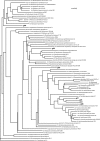Diversity of glycosyl hydrolases from cellulose-depleting communities enriched from casts of two earthworm species
- PMID: 20622123
- PMCID: PMC2935051
- DOI: 10.1128/AEM.00902-10
Diversity of glycosyl hydrolases from cellulose-depleting communities enriched from casts of two earthworm species
Abstract
The guts and casts of earthworms contain microbial assemblages that process large amounts of organic polymeric substrates from plant litter and soil; however, the enzymatic potential of these microbial communities remains largely unexplored. In the present work, we retrieved carbohydrate-modifying enzymes through the activity screening of metagenomic fosmid libraries from cellulose-depleting microbial communities established with the fresh casts of two earthworm species, Aporrectodea caliginosa and Lumbricus terrestris, as inocula. Eight glycosyl hydrolases (GHs) from the A. caliginosa-derived community were multidomain endo-beta-glucanases, beta-glucosidases, beta-cellobiohydrolases, beta-galactosidase, and beta-xylosidases of known GH families. In contrast, two GHs derived from the L. terrestris microbiome had no similarity to any known GHs and represented two novel families of beta-galactosidases/alpha-arabinopyranosidases. Members of these families were annotated in public databases as conserved hypothetical proteins, with one being structurally related to isomerases/dehydratases. This study provides insight into their biochemistry, domain structures, and active-site architecture. The two communities were similar in bacterial composition but significantly different with regard to their eukaryotic inhabitants. Further sequence analysis of fosmids and plasmids bearing the GH-encoding genes, along with oligonucleotide usage pattern analysis, suggested that those apparently originated from Gammaproteobacteria (pseudomonads and Cellvibrio-like organisms), Betaproteobacteria (Comamonadaceae), and Alphaproteobacteria (Rhizobiales).
Figures




References
-
- Anisimova, M., and O. Gascuel. 2006. Approximate likelihood ratio test for branches: a fast, accurate and powerful alternative. Syst. Biol. 55:539-552. - PubMed
Publication types
MeSH terms
Substances
Associated data
- Actions
- Actions
- Actions
- Actions
- Actions
- Actions
- Actions
- Actions
- Actions
- Actions
- Actions
- Actions
- Actions
- Actions
- Actions
- Actions
- Actions
- Actions
- Actions
- Actions
- Actions
- Actions
- Actions
- Actions
- Actions
- Actions
- Actions
- Actions
- Actions
- Actions
- Actions
- Actions
- Actions
- Actions
- Actions
- Actions
- Actions
- Actions
- Actions
- Actions
- Actions
- Actions
- Actions
- Actions
- Actions
- Actions
- Actions
- Actions
- Actions
- Actions
- Actions
- Actions
- Actions
- Actions
- Actions
- Actions
- Actions
- Actions
- Actions
- Actions
- Actions
- Actions
- Actions
- Actions
- Actions
- Actions
- Actions
- Actions
- Actions
- Actions
- Actions
- Actions
- Actions
- Actions
- Actions
- Actions
- Actions
- Actions
- Actions
- Actions
- Actions
- Actions
- Actions
- Actions
- Actions
- Actions
- Actions
- Actions
- Actions
- Actions
- Actions
- Actions
- Actions
- Actions
- Actions
- Actions
- Actions
- Actions
- Actions
- Actions
- Actions
- Actions
- Actions
- Actions
- Actions
- Actions
- Actions
- Actions
LinkOut - more resources
Full Text Sources
Molecular Biology Databases

